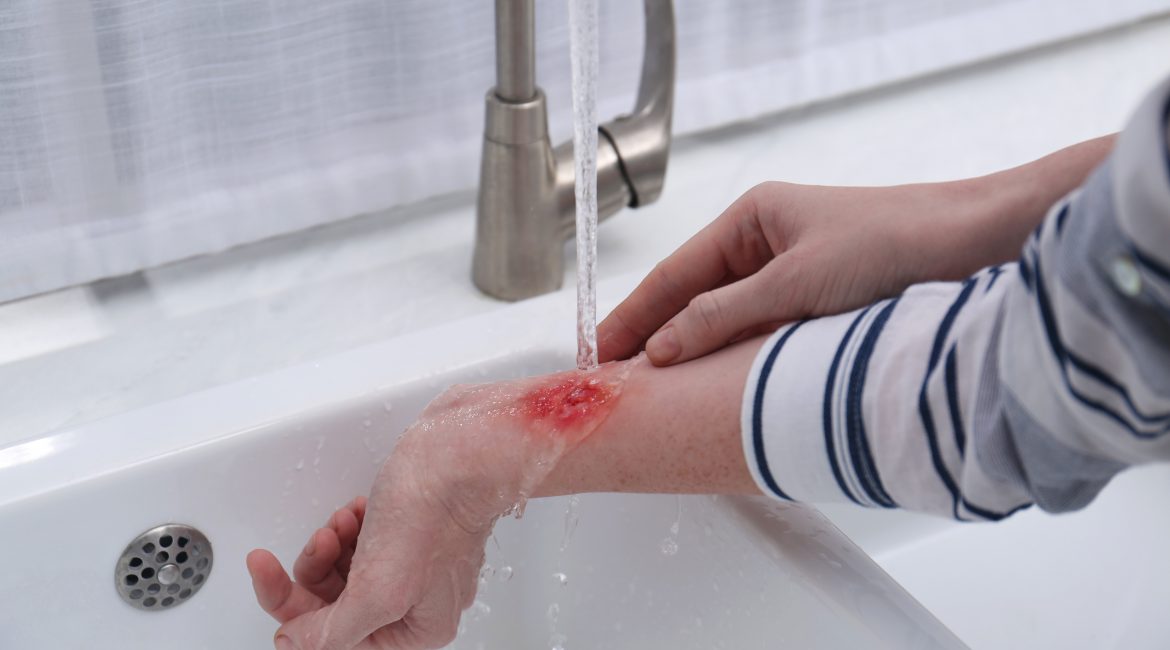Burns are one of the most common household injuries, they really do happen to all of us. Here’s what to know about how to treat a burn at home and when you should seek medical attention…
You just burnt your hand on a pan of freshly baked cookies, you spent too much time in the sun, or your spilt hot tea on yourself – no matter how you got burnt, it’s never a pleasant situation to be in.
If the burn is more serious (we’ll get to this in a bit), then you will need to see a doctor. And if want to finally be able to afford to see your private doctor, then make sure you have health insurance.
When can I treat a burn at home?
Burns are placed in categories based on how severe they are.
A 1st-degree burn is seen as the least serious because only the outer layer of your skin is affected. This kind of burn normally causes mild redness, swelling and pain.
A 2nd-degree burn will affect the deeper layers of your skin and cause blisters, wet, shiny, and white skin.
A 3rd-degree burn involves serious damage to all layers of your skin and a 4th-degree burn may even involve bones and joints. 3rd and 4th-degree burns are seen as medical emergencies and HAVE to be treated in hospital.
Read more: Does Health Insurance Cover Emergency Room Triage Treatment?
Most 1st and 2nd degree burns that are smaller than 8cm in diameter can be treated at home.
The top home remedies for how to treat a burn at home
Mild burns will normally take about one or two weeks to heal and normally do not cause any scarring. The goal of treating these burns is to reduce the pain, prevent any infection, and help the skin to heal faster.
Here are some ways to treat a mild burn at home:
1. Cool water
The first thing you need to do when you burn yourself is to place the burn under COOL (not cold) water for about 20 mins. Then wash this area with a bar of mild soap and some water.
2. Cool compression
Then, use a cool compress or a clean wet cloth and place this over the burn to relieve any swelling and pain. Apply this compress for 5 to 15 mins, then leave for 5 to 15 mins and repeat 2 to 3 times. Do not use the compress more than you need to as it may irritate the burn.
3. Apply ointment
Use a topical cream or ointment made for burns. Bactroban and Germolene are great for minor burns. Cover the burn with cling wrap or a non-fluffy dressing cloth.
Aloe vera is also a great and natural solution to apply to burns. This plant also stops inflammation and the growth of bacteria. If you buy an aloe vera product from a store, make sure the ointment does not have any alcohol or fragrance added to it.
4. Honey
This is an age-old natural form of treatment – honey is great for minor burns as it acts as an anti-inflammatory and naturally anti-bacterial agent.
5. Stay out of the sun
Do not let your burn be exposed to direct sunlight as this will agitate the area.
6. Do not pop the blisters
Leave your blisters alone as bursting one can result in infection. If your blisters are serious and very painful, you should see your doctor.
7. Take an over-the-counter (OTC) pain reliever
Go to your local pharmacy and ask them for something to relieve the pain.
DO NOT USE these home remedies!
1. Butter
Butter retains heat and could make your burn worse!
2. Oils
Do not apply any oils to a burn (even coconut oil). Some believe that lavender oil may work, but there are only animal studies done to support this claim.
3. Egg whites
Eggs can cause infection and an allergic reaction.
4. Toothpaste
Toothpaste will only irritate your burn further.
5. Ice
Ice can also irritate the burn as well as very cold water.
When should I see a doctor for my burn?
It is vital that you know when you need professional care and when you can treat your burn at home. You should see a doctor if:
- The burn is bigger than 8cm in diameter.
- The burn is on your face, hands, buttocks, and/or groin area.
- Your wound is very painful and starts to smell.
- You have a fever after a while.
If you have a 3rd or 4th-degree burn, then you need to see your doctor immediately. Symptoms of these kinds of burns include:
- White and waxy skin
- Dark brown or charred skin
- Leathery and raised skin
If you are in serious pain and think you have a severe burn, then see your doctor as soon as possible so that the right treatment can begin.
Health Insurance for Peace of Mind in Emergencies
When you’re in an emergency situation like getting a 3rd or 4th degree burn, there’s no time to consider whether you can afford to go to the emergency room or not. This is when health insurance comes to the rescue to make sure you can get private, high-quality medical care without the crazy expensive bill.
Oneplan (that’s us) offers a range of Health Insurance plans to suit your needs and budget – whether you’re looking for an Accident Only Plan to cover you in emergencies or an Executive Plan with all the bells and whistles – we’ve got you covered.
Plus, we let you keep your favourite doctor as we don’t use provider networks, and if you’re looking for even more affordable healthcare, you can get our Excess Buster Add-On and never worry about paying excess again!
Click here to join the Oneplan Health Family today, or you can speak to one of our friendly service agents if you need a bit more information.
Your Health Insurance Family,
Oneplan




